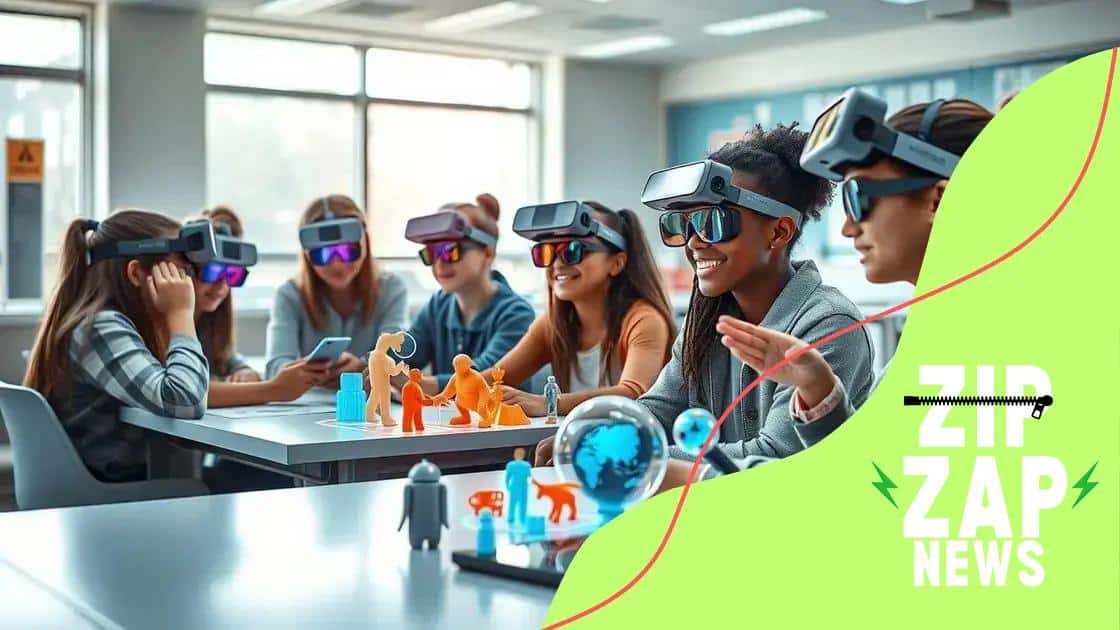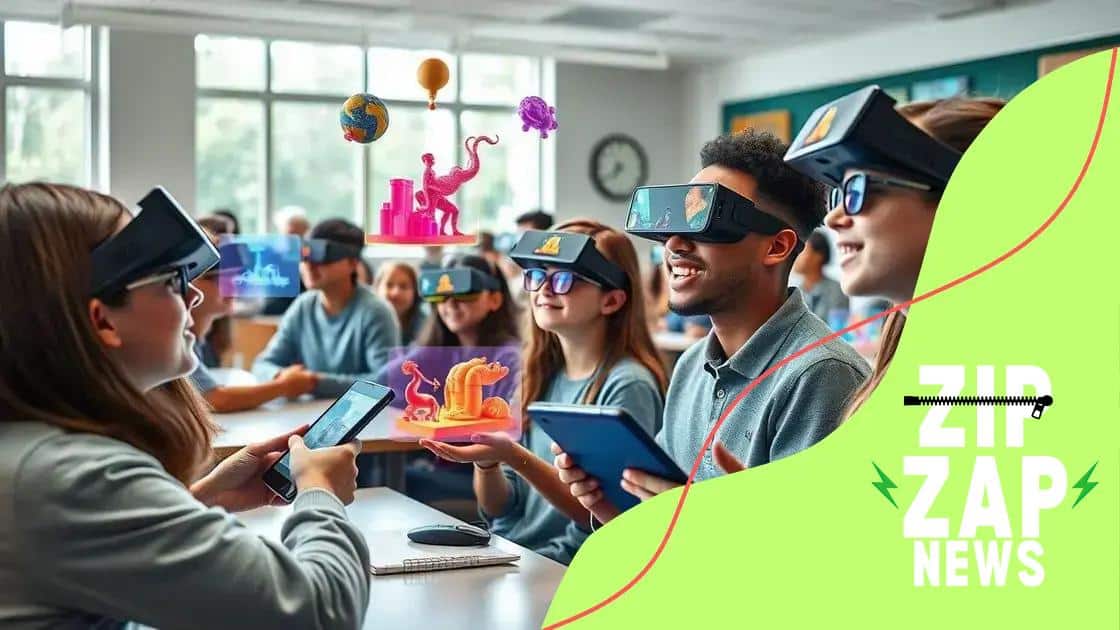How AR is being used for hands-on learning experiences

Augmented reality (AR) enhances hands-on learning experiences by making education interactive, engaging students with 3D models and simulations while addressing challenges such as cost and teacher training.
How AR is being used for hands-on learning experiences can reshape traditional education. Have you ever imagined a classroom where students can interact with 3D models right in front of their eyes? Let’s dive into this exciting blend of technology and learning!
Understanding augmented reality in education
Understanding augmented reality in education is essential as more schools embrace innovative technology. This method creates engaging learning environments and enhances comprehension.
What is Augmented Reality?
Augmented reality (AR) adds digital elements to the real world. Unlike virtual reality, which immerses users in a completely digital environment, AR overlays information on our surroundings. This can include 3D images, sounds, and other sensory enhancements.
How AR Enhances Learning
Teachers can use AR to make complex topics simpler and more relatable for students. For example, biology classes can come alive with 3D models of cells that students can explore. This interactive experience caters to different learning styles and makes education more engaging.
- Visual Learners: They benefit from seeing concepts in action, making learning memorable.
- Kinesthetic Learners: AR provides hands-on experiences that enhance practical skills.
- Auditory Learners: Interactive audio components in AR can reinforce lessons.
Incorporating AR into lessons not only captures attention but also fosters curiosity. Imagine a history lesson where students can walk through ancient civilizations or a chemistry class where they can conduct virtual experiments without any risks.
Challenges in Adoption
Despite its benefits, there are challenges in adopting AR in education. Schools need the proper technology and infrastructure. Training teachers to use AR effectively also plays a crucial role. Moreover, educators must ensure that AR content aligns with learning objectives.
Augmented reality continues to evolve, and as it does, it opens new avenues for teaching and learning. As more resources become available, the possibilities for hands-on learning experiences will expand, leading to a more engaging and fun classroom environment.
Benefits of AR for hands-on learning
Benefits of AR for hands-on learning are becoming increasingly clear as educators explore interactive ways to engage students. By integrating augmented reality into lessons, teachers can transform traditional education into a lively and immersive experience.
Enhanced Engagement
One of the significant benefits is heightened student engagement. With AR, lessons become dynamic and compelling, making students eager to participate. For example, when learning about space, a classroom can fill with 3D models of planets that students can manipulate with their devices. This interactive setup not only captures their attention but also boosts understanding.
Tailored Learning Experiences
AR also allows for personalized learning. Students can learn at their own pace, exploring topics that interest them deeply. During a biology lesson, for instance, students can use AR apps to explore cellular structures up close. This method caters to visual and kinesthetic learners, allowing them to grasp complex ideas effectively.
- Increased Retention: Because AR experiences are interactive, students are more likely to remember what they’ve learned.
- Collaboration Opportunities: AR can foster teamwork as students work together to solve problems, thereby enhancing social skills.
- Real-World Applications: By simulating real-life scenarios, AR helps students connect what they learn in class to practical situations.
Furthermore, AR technology makes learning enjoyable. It encourages creativity, allowing students to express themselves through various projects that utilize AR tools. Whether it’s creating a virtual presentation or developing a digital art piece, the possibilities are endless.
Improved Accessibility
Lastly, AR can improve accessibility for students with different learning needs. It offers multiple ways to present information, catering to diverse learning styles. Students who struggle with traditional methods may find AR content easier to understand, which can enhance their overall learning experience.
As educators weigh the benefits of AR for hands-on learning, they uncover a wealth of opportunities to enrich the classroom and inspire the next generation of learners. The integration of technology into education promises exciting advancements in how students engage with complex material and ideas.
Real-world applications of AR in classrooms

Real-world applications of AR in classrooms showcase how this technology can transform learning experiences. Teachers around the globe are adopting AR tools to create interactive and engaging lessons.
Interactive Lessons
One effective application is using AR to bring textbook content to life. For example, in a history lesson, students can use AR apps to see historical events unfold right in front of them. They can scan images in their books to access videos or 3D models that illustrate important concepts.
Science Experiments
In science classes, AR can simulate experiments that may be too dangerous or expensive to conduct. For instance, students can use AR to explore the human body. They can visualize organs and systems in 3D, providing a hands-on experience that deepens their understanding.
- Virtual Field Trips: AR allows students to experience places beyond the classroom. They can explore the Amazon rainforest or visit ancient ruins without leaving their seats.
- Art and Design: In art classes, students can create virtual exhibits and see how their artwork would look in real-world settings using AR tools.
- Mathematics: AR can visualize complex 3D shapes and geometric concepts, making it easier for students to grasp mathematical ideas.
Furthermore, the use of AR can enhance collaborative projects. Students can work in groups to create AR presentations, allowing them to share knowledge and ideas visually. This teamwork promotes communication and strengthens problem-solving skills.
Language Learning
AR also finds its applications in language learning. Students can use AR to interact with virtual characters that speak the language they are learning. This immersive experience can increase vocabulary retention and improve pronunciation.
As educators explore these real-world applications, the potential for AR in classrooms continues to grow. This technology not only enriches lessons but also prepares students for a future where such tools will be commonplace.
Challenges in implementing AR technology
Challenges in implementing AR technology in classrooms are essential to consider. While the benefits are clear, schools face many obstacles when introducing augmented reality into their teaching methods.
Cost of Implementation
One major challenge is the cost associated with AR technology. Schools may need to invest in new hardware and software tools. Tablets, smartphones, and AR glasses can be expensive, making budget allocation a critical issue for many educational institutions.
Training and Support
Another challenge is the need for teacher training. Educators must learn how to use AR tools effectively. Many teachers may feel overwhelmed or unsure about incorporating this technology into their lessons.
- Lack of Professional Development: Schools often do not provide sufficient training programs for teachers.
- Time Constraints: Teachers already have busy schedules, making it hard to find time to learn new technologies.
- Technical Support: Ongoing support is crucial, but many schools do not have the resources for reliable technical assistance.
Furthermore, the content available for AR is sometimes limited. Educators may struggle to find relevant materials that align with their curriculum. This limitation can hinder the full potential of AR in enhancing learning experiences.
Student Accessibility
Additionally, not all students can access the technology required for AR. Some students may not have devices or reliable internet connections at home. This digital divide can lead to unequal learning opportunities among students.
Finally, there can be resistance from both teachers and parents. Some educators might be hesitant to adopt new technology, while parents may feel concerned about their children’s screen time. Addressing these concerns is vital for successful implementation.
As schools work to integrate AR into education, understanding these challenges can help stakeholders create effective strategies for overcoming them and maximizing the benefits of augmented reality in classrooms.
Future trends for AR in learning environments
Future trends for AR in learning environments suggest exciting possibilities for education. As technology advances, augmented reality will play an even more significant role in shaping how students learn.
Integration with AI
One major trend is the integration of AR with artificial intelligence (AI). This combination can create personalized learning experiences for students. By understanding each student’s strengths and weaknesses, AR applications can adapt content to fit their needs, enhancing comprehension and retention.
Improved Accessibility
Moreover, future AR technology will focus on improving accessibility. Educators are working on tools that will be more inclusive, ensuring all students can benefit from interactive lessons. This includes adapting AR content for various learning disabilities, making education more equitable.
- Wearable Technology: Future AR experiences could be enhanced with wearable devices like smart glasses, allowing for hands-free interaction.
- Cloud-Based Solutions: These tools will make AR applications easier to manage, enabling schools to update content quickly and share resources across platforms.
- Virtual Reality Integration: Combining AR with VR can create fully immersive learning environments, allowing for virtual field trips to anywhere in the world.
Additionally, the development of open-source AR platforms will encourage more educators and developers to create engaging content. This shift can lead to a richer pool of resources for students and teachers alike, with many adapting lessons to suit specific curriculum needs.
Collaborative Learning Experiences
Future AR trends will also emphasize collaboration. Students will work together within an AR environment to solve problems or complete projects. This can foster teamwork and critical thinking skills, essential for future success.
As AR technology continues to evolve, the possibilities for enhancing learning environments are vast. Schools and educators will need to stay informed about these advancements to utilize AR fully and effectively in the classroom.
FAQ – Frequently Asked Questions about AR in Education
What are the main benefits of using AR in classrooms?
AR enhances student engagement, fosters personalized learning experiences, and promotes collaboration among students.
What challenges do schools face when implementing AR technology?
Schools often struggle with costs, necessary training for teachers, and ensuring all students have access to the required devices.
How does AR improve hands-on learning experiences?
AR brings complex subjects to life, allowing students to interact with 3D models and simulations, making learning more effective.
What trends can we expect in the future of AR in education?
Future trends include integrating AR with AI for personalized learning, improving accessibility for all students, and developing collaborative learning experiences.





